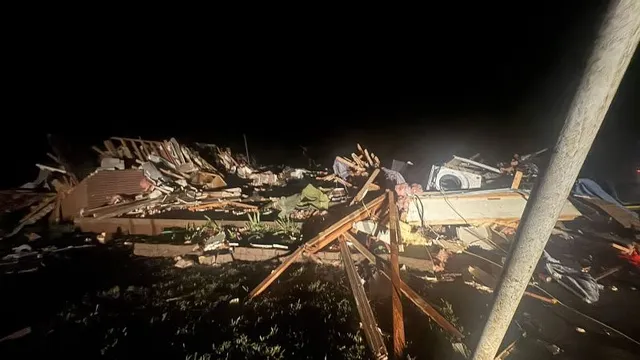
30 million brace for more severe weather after deadly tornadoes
2025-05-20 16:05- Over 30 million people are facing the threat of severe storms across multiple states.
- Since last Thursday, more than 250 tornadoes have been reported, resulting in 28 fatalities.
- The weather pattern is expected to continue, raising further concerns for public safety.
Express your sentiment!
Insights
In the U.S., a series of devastating storms has resulted in significant loss of life and destruction across central and southern regions, particularly affecting Kentucky, Missouri, and other states. Since last Thursday, over 250 tornadoes have been reported, leading to at least 28 fatalities, including 19 in Kentucky. The National Weather Service has classified the situation as a multiday severe weather outbreak, predicting further storms and potential tornadoes extending across various regions. Weather conditions remain conducive for severe thunderstorms due to an enhanced jet stream, typical for May, which is known for heightened tornado activity. Areas from Texas to Illinois are particularly vulnerable, as severe weather poses ongoing risks following earlier destructive tornadoes. In Kansas and Texas, emergency services are responding to damages from recent tornado activity, and communities are left picking up the pieces after the devastation. The Storm Prediction Center has issued heightened risk alerts, forecasting dangerous thunderstorms and potential tornado occurrences throughout the workweek. As this weather pattern shifts, it is expected to impact the Tennessee Valley, threatening cities across Arkansas, Tennessee, and Alabama. While the initial storms are severe, authorities express concern for flash flooding as rains continue to accumulate. Weather forecasts indicate extreme temperatures contributing to instability, exacerbating the severe storm threat. With many areas already saturated from recent precipitation, the risk for flash flooding has increased. As first responders search for victims and assist affected residents, there are calls for federal disaster assistance, highlighting the ongoing severity of the situation. This multiday pattern of severe weather is unprecedented for the region and raises serious concerns for public safety in the days to come.
Contexts
Tornadoes are among the most violent and destructive weather phenomena on Earth, particularly prevalent in the United States. The history of tornadoes in the U.S. has been marked by significant events that have shaped both the understanding of these storms and the measures taken to protect life and property. The frequency and intensity of tornadoes are most commonly associated with the region known as "Tornado Alley," which stretches from Texas through Oklahoma, Kansas, Nebraska, and into South Dakota. This area is not exclusive, as tornadoes have occurred in every state, but the concentration in this region results from the unique geographical and meteorological conditions conducive to tornado formation. The combination of warm, moist air from the Gulf of Mexico colliding with cooler, drier air from Canada creates the perfect setup for severe thunderstorms, which are the precursors to tornadoes. The earliest recorded tornadoes in the U.S. date back to the colonial period in the 17th century, with more systematic studies emerging in the 19th century. The destruction caused by tornadoes has often led to significant loss of life and property, with notable events such as the Tri-State Tornado of 1925, which remains one of the deadliest in U.S. history, claiming 695 lives and injuring over 2,000 people. This catastrophic event underscored the need for better warning systems and preparedness measures. Following such incidents, the National Weather Service (NWS) was established in 1890, eventually developing advanced radar technology and forecasting models that significantly improved tornado detection and warning capabilities. In recent decades, advancements in meteorology and technology have further enhanced our understanding of tornadoes. Doppler radar, for example, has revolutionized storm tracking and provided meteorologists with the ability to detect rotation within thunderstorms, which helps predict tornado formation. The introduction of enhanced Fujita (EF) scale in 2007 helped categorize tornadoes based on the damage they cause, providing a clearer assessment of their intensity. Annual tornado occurrences in the U.S. have shown a degree of variability, influenced by climatic factors and seasonal patterns, with averages ranging from 900 to over 1,000 tornadoes reported annually. Although the increased frequency of EF-2 and stronger tornadoes has raised concerns regarding climate change, ongoing research continues to explore the complexities surrounding tornado occurrences and their links to broader weather patterns. Despite improvements in forecasting and public education on tornado safety, challenges remain. Many tornadoes, especially those of short duration and small scale, can occur with little warning, posing significant risks to communities. The integration of public alerts through technology and social media plays a critical role in reaching residents during severe weather events. As communities adapt to the risks of tornadoes, ongoing efforts to improve infrastructure, enhance warning systems, and foster public awareness are essential in minimizing damage and saving lives. With continued advancement in meteorological science, the hope is to better predict, prepare for, and ultimately reduce the impact of tornadoes across affected regions.